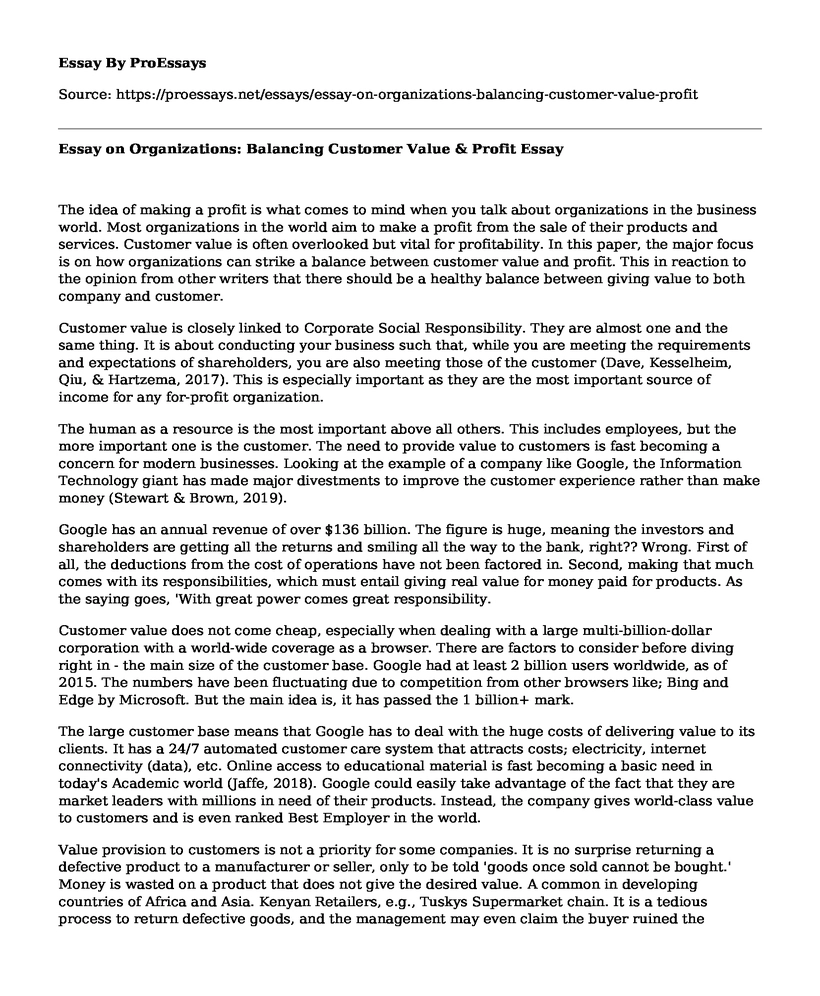The idea of making a profit is what comes to mind when you talk about organizations in the business world. Most organizations in the world aim to make a profit from the sale of their products and services. Customer value is often overlooked but vital for profitability. In this paper, the major focus is on how organizations can strike a balance between customer value and profit. This in reaction to the opinion from other writers that there should be a healthy balance between giving value to both company and customer.
Customer value is closely linked to Corporate Social Responsibility. They are almost one and the same thing. It is about conducting your business such that, while you are meeting the requirements and expectations of shareholders, you are also meeting those of the customer (Dave, Kesselheim, Qiu, & Hartzema, 2017). This is especially important as they are the most important source of income for any for-profit organization.
The human as a resource is the most important above all others. This includes employees, but the more important one is the customer. The need to provide value to customers is fast becoming a concern for modern businesses. Looking at the example of a company like Google, the Information Technology giant has made major divestments to improve the customer experience rather than make money (Stewart & Brown, 2019).
Google has an annual revenue of over $136 billion. The figure is huge, meaning the investors and shareholders are getting all the returns and smiling all the way to the bank, right?? Wrong. First of all, the deductions from the cost of operations have not been factored in. Second, making that much comes with its responsibilities, which must entail giving real value for money paid for products. As the saying goes, 'With great power comes great responsibility.
Customer value does not come cheap, especially when dealing with a large multi-billion-dollar corporation with a world-wide coverage as a browser. There are factors to consider before diving right in - the main size of the customer base. Google had at least 2 billion users worldwide, as of 2015. The numbers have been fluctuating due to competition from other browsers like; Bing and Edge by Microsoft. But the main idea is, it has passed the 1 billion+ mark.
The large customer base means that Google has to deal with the huge costs of delivering value to its clients. It has a 24/7 automated customer care system that attracts costs; electricity, internet connectivity (data), etc. Online access to educational material is fast becoming a basic need in today's Academic world (Jaffe, 2018). Google could easily take advantage of the fact that they are market leaders with millions in need of their products. Instead, the company gives world-class value to customers and is even ranked Best Employer in the world.
Value provision to customers is not a priority for some companies. It is no surprise returning a defective product to a manufacturer or seller, only to be told 'goods once sold cannot be bought.' Money is wasted on a product that does not give the desired value. A common in developing countries of Africa and Asia. Kenyan Retailers, e.g., Tuskys Supermarket chain. It is a tedious process to return defective goods, and the management may even claim the buyer ruined the product themselves (Sultana, & Ashraf, 2019). This shows little to no concern about customer needs.
Goods and services are in many forms. There are basic needs, and there are goods of ostentation (luxury goods). They include jewelry, high-quality clothes, and even high-end foods, e.g., white strawberries and black watermelons on Hokkaido Island, Japan, which once auctioned for a whopping $ 6300 (Hanel, 2006). But let's look at basic goods. Normally, people hardly get value for some products because they can't live without them. This means that the companies sort to take advantage of the situation where people have no choice but to buy their products regardless of quality just to survive.
References
Dave, C., Kesselheim, A., Fox, E., Qiu, P., & Hartzema, A. (2017). High Generic Drug Prices and Market Competition. Annals of Internal Medicine, 167(3), 145-151. doi: 10.7326/m16-1432
Hanel, P. (2006). Intellectual Property Rights Business Management Practices: A Survey of the Literature. Technovation, 26(8), 895-931. doi: 10.1016/j.technovation.2005.12.001
Jaffe, S. (2018). Trump unveils plan to cut drug prices. The Lancet, 391(10136), 2197-2198. doi: 10.1016/s0140-6736(18)31215-7
Stewart, G. L., & Brown, K. G. (2019). Human resource management. Wiley.
Sultana, B., & Ashraf, R. (2019). Watermelon Oil. In Fruit Oils: Chemistry and Functionality (pp. 741-756). Springer, Cham.
Cite this page
Essay on Organizations: Balancing Customer Value & Profit. (2023, Mar 02). Retrieved from https://proessays.net/essays/essay-on-organizations-balancing-customer-value-profit
If you are the original author of this essay and no longer wish to have it published on the ProEssays website, please click below to request its removal:
- Case Study of Domino's Pizza
- Goals, Milestone and Exit Strategy Paper Example
- Corporate Insider Threat Detection Paper Example
- Essay on HRM Powers for Smooth Operations: A Netflix Case Study
- McDonald's: Healthy Options for Your Unique Needs - Essay Sample
- Convenience Store Responsiveness: Strategies for Market Dominance - Essay Sample
- Paper Sample - Optimizing Fire Service Promotions: A Focus on CPI and Caliper Profile Tools







